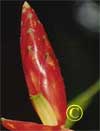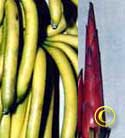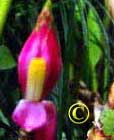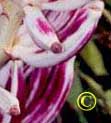Musa textilis which
grows to about 5 meters high. Due its fibers it has been used for many
commodities like ropes and fabric. It is the largest and most common of
the group.
Select thumbnail for larger image.
|

|
Musa beccarii which
only reaches about 1.5 meters high. It is highly ornamental red inflorescence
or "flower" and could be grown and flowering easily in containers.
Select thumbnail for larger image.
|

|
Musa lawitiensis
reaches about 1.5 - 2 meters high. It is heliconia type ornamental banana.
As far as I know it has never been tested in containers.
Select thumbnail for larger image.
|

|
Musa campestris (variety
1, hot pink flower) reaches about 1.5 meters high. It is highly ornamental
with a hot pink inflorescence or "flower" and green fruit. It should
be tried in containers.
Select thumbnail for larger image.
|

|
Musa campestris
(variety 2, purple and white flower) reaches about 1.5 meters
plant. It is highly ornamental with a pale inflorescence or "flower" trimmed
in purple. The fruit are also purple and white. It should be tried in containers.
I have never seen a banana coloured quite like this one, all five are unique
but this one stands above the rest.
Select thumbnail for larger image.
|

|
|
|




